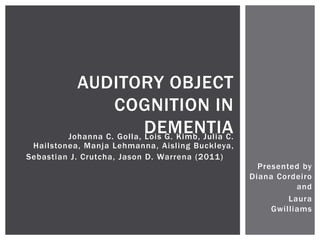
Auditory Object Recognition: Evidence from Aphasia
- 1. AUDITORY OBJECT COGNITION IN DEMENTIA Johanna C. Golla, Lois G. Kimb, Julia C. Hailstonea, Manja Lehmanna, Aisling Buckleya, Sebastian J. Crutcha, Jason D. Warrena (2011) Presented by Diana Cordeiro and Laura Gwilliams
- 2. BACKGROUND Deficits people with dementia face have been widely studied Visual object processing deficits are well established But the cognition of nonverbal sounds (i.e., auditory objects) in dementia has been relatively little explored Similarities exist between the two domains, but a ‘visual object’ is much more concrete and easily defined than an ‘auditory object’
- 3. AUDITORY OBJECT? Auditory objects are made up of acoustic properties which are processed by the hearer Recognise sound characteristics And, properties of the object that created the sound Unclear how the brain processes an object in the auditory domain, especially for people with dementia syndromes
- 4. WHY STUDY THE AUDITORY DOMAIN? 1) Clinical Perspective Disorders of auditory processing gives rise to a diverse host of symptoms and deficits 2) Cognitive Neuropsychological Perspective Determine cognitive components required to process an auditory object Relation between these essential components and the study of damaged brains
- 5. AIMS Build upon previous study: 1) Extend investigation to include patients diagnosed with Alzheimer’s disease (AD) and Primary Progressive Aphasias (PPA) 2) Assess auditory object cognition while taking working memory into consideration 3) Extend analysis of auditory object cognition to include a wider range of processes including early perceptual mechanisms Goll, J. C., Crutch, S. J., Loo, J. H., Rohrer, J. D., Frost, C., Bamiou, D. E., et al. (2010). Non-verbal sound processing in the primary progressive aphasias. Brain, 133, 272–285.
- 6. METHOD Participants 20 healthy age-matched controls 34 patients fulfilling clinical diagnostic criteria for AD or PPA Clinically diagnosed with: Amnestic Alzheimer’s disease (AD; n-21) Progressive non-fluent aphasia (PNFA; n-5) Logopenic progressive aphasia (LPA; n-7) Aphasia associated with granulin gene mutation (GAA; n-1) Pre-experimental assessment Peripheral hearing assessment General neurological function assessment
- 7. DESIGN: EXPERIMENTAL BATTERY The battery allows assessment of three levels of cognitive auditory processing: 1) Early perceptual coding at subcortical level (sub -object) i.e., pitch, timbre, auditory size 2) Perceptual representations (whole object) i.e., combined sub-object properties 3) Recognition of auditory objects (semantics) i.e., object -> meaning
- 8. METHOD: EXPERIMENTAL BATTERY Experimenters designed a novel battery to probe auditory object cognition
- 9. RESULTS Comparisons between syndromes and control AD PNFA LPA GAA Pitch change detection Preserved Preserved Pitch change direction Deficit Deficit Timbre Preserved Deficit Deficit Preserved Size familiar Preserved Preserved Preserved Preserved Size unfamiliar Preserved Preserved Preserved Preserved Apperceptive Deficit Preserved Deficit Semantic Preserved Deficit Preserved After adjusting for non-verbal working memory performance
- 10. CONCLUSIONS Dementia syndromes are associated with impaired processing of auditory objects Separable stages of auditory object analysis Separable profiles of impaired auditory object cognition in dif ferent dementia syndromes Working memory was an important aspect of auditory recognition Taken together, results suggest dementia syndromes are associated with distinctive profiles of auditory object processing
- 11. LIMITATIONS Small case numbers Deficits occurred in context of general auditory dysfunction and widespread cognitive impairment Cannot make direct anatomical and pathological link to deficits observed None of the deficits were restricted to a particular dementia syndrome
- 12. FUTURE RESEARCH Larger patient cohorts and additional neurodegenerative diseases Clinical perspective: Core symptoms of disorders could be better understood with further study into auditory dysfunction Cognitive Neuropsychological perspective: Establish relationship between different elements of auditory object perception Explore processes for object segregation in embedded complex auditory scenes Compare mechanisms of object analysis across different modalities, using appropriate matched tasks in each modality
Notas do Editor
- laura
- Laura
- diana
- dianaPrior study into PNFA and SDPrevious study was into Primarynonfluent aphasia.. Previous study didn’t take WM into consideration
- DianaPrimary progressive aphasia
- dianaEarly stage of perceptual coding at the subcortical level, pitch and pitch change
- Laura - experimental design was forced choice, uni-modal and single auditory object at a time to reduce STM demands - 7 elements to investigate the three levels of cognitive auditory processing - early perceptual was studied through sub-object sounds which corresponded to a single sound characteristic - perceptual representations investigated through apperceptive task where the sound was computationally degraded and the participants were asked to say wherther the sound was created by a particular object category, in this instance ‘tool’ or ‘animal’ - semantic recognition of objects looked at a further level where the participants had to say whether the particular function that the object served was outside or inside.Subcortical // perceptual (combo of sub-object) // semantic, the meaning of these objectsVisual diagrams: Familiarise subjects with each testPitch and timbre tests – directional arrowsAuditory size test – words ‘big’ and ‘small’Apperceptive test – canonical examples of tools and animalsSemantic test – photographs of interior and exterior scenes
- diana
- diana
- Laura - small case nubers, especially in the granulin gene mutation who had one participant, but this is inherent in studies of this kind - cannot make correlational claims to link the audiotry deficits to the anatomical and pathological observations because general auditory dysfunction was found as well as widespread cognitive impairment - none of the deficits were completely restricted to a particular syndrome, suggesting there is a level of overlap between the auditory processing of these elements
- Laura – make within and across dementia generalisations - study auditory dysfunction further to better understand the core symptoms of the disorder - relationship between different elements of auditory object perception - object segregation within context; maybe context helps some people not others - look at cross-modal perception because the combination of domains is how the world is experieneed in reality, so should look at how they interact